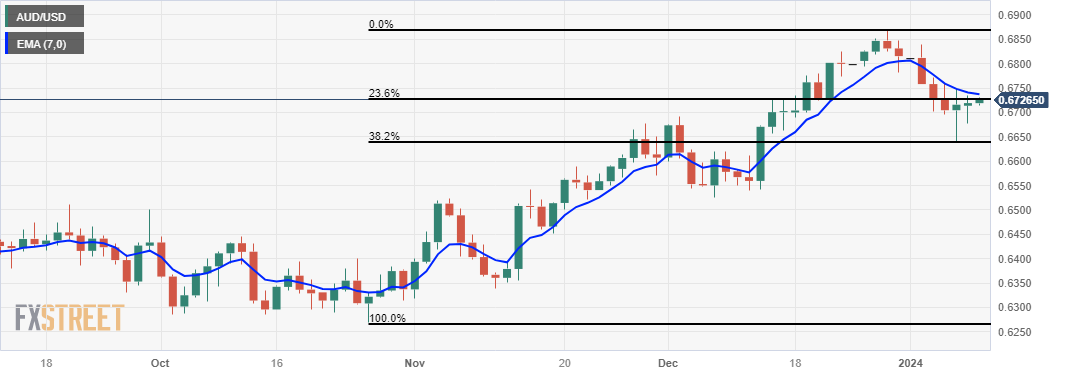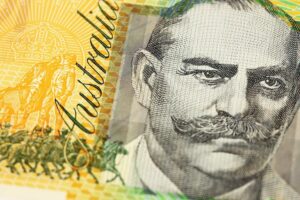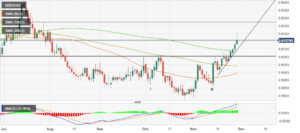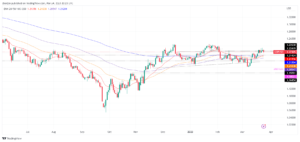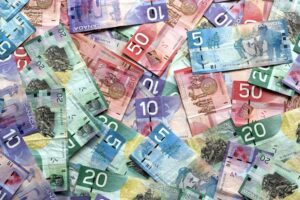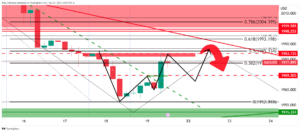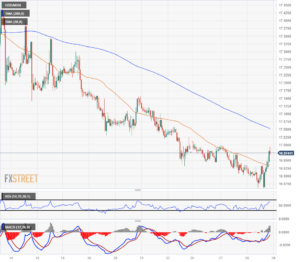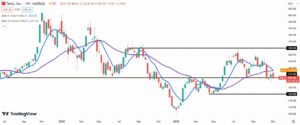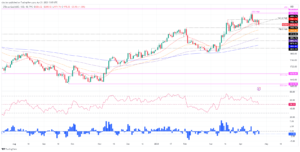- Australian Dollar continues its winning streak on the softer US Dollar.
- Australian Retail Sales increased to 2.0% from the previous 0.2% decline.
- Improved risk appetite weakens the Greenback.
- Atlanta Fed President Raphael W. Bostic expects two quarter-point cuts by the end of 2024.
The Australian Dollar (AUD) continues to gain ground, extending its gains for the third successive session on Tuesday. The AUD/USD pair seems to be benefiting from improved risk appetite, driven in part by comments from US Federal Reserve (Fed) members speculating about potential interest rate cuts by the end of 2024. Additionally, the upbeat economic data from Australia could reinforce the strength of the Aussie Dollar (AUD).
Australia’s Bureau of Statistics revealed the seasonally adjusted Retail Sales (MoM) for November, which rose by 2.0% instead of the expected 1.2%, swinging from the previous 0.2% decline. Furthermore, the monthly Building Permits came to 1.6% from 7.5% prior against the expected decline of 2.0%.
Traders will observe the Monthly Consumer Price Index data on Wednesday to gain more impetus on the Reserve Bank of Australia’s (RBA) interest rate trajectory. However, RBA is highly anticipated to refrain from rate cuts in its upcoming February meeting.
The US Dollar Index (DXY) seems to extend its losses due to the decline in US Treasury yields. Additionally, the softer comments from the Fed members triggered the risk-on market mood, which put pressure on the US Dollar (USD).
Atlanta Fed President Raphael W. Bostic shared insights on the 2024 economic outlook during an appearance at the Atlanta Rotary Club on Monday. Notably, he mentioned that inflation has declined more than initially anticipated and expressed the view of expecting two quarter-point cuts by the end of 2024. Bostic conveyed comfort with the current rate level and emphasized the importance of allowing the Fed's tight policy time to work on cooling off inflation. He also mentioned that the US is on the path to achieving 2% inflation, and the goal is to remain on that path.
US Fed Governor Michelle W. Bowman addressed the South Carolina Bankers Association 2024 Community Bankers Conference on Monday. She mentioned that inflation could fall further with the policy rate held steady for some time. Bowman expressed the view that the current policy stance appears sufficiently restrictive, but it might eventually become appropriate to lower the Fed's policy rate if inflation falls closer to the 2% target.
Daily Digest Market Movers: Australian Dollar rises on improved risk appetite
- Australia Judo Bank Services PMI reported a reading of 47.1, falling short of market expectations that it would remain consistent at 47.6. The Composite PMI decreased to 46.9 from the previous figure of 47.4.
- Australia’s Judo Bank Manufacturing PMI indicated a modest contraction in manufacturing activity, declining to 47.6 in December from the previous reading of 47.8.
- Chinese wealth manager Zhongzhi Enterprise Group has filed for bankruptcy liquidation, facing a staggering $64 billion in liabilities.
- Dallas Fed President Lorie K. Logan, provided insights on Saturday, suggesting that a rate hike should not be ruled out given the recent easing in financial conditions. She emphasized the importance of avoiding premature easing, which could stimulate demand. Maintaining sufficiently tight financial conditions is seen as crucial to managing the risk of inflation picking back up and potentially reversing progress.
- US Nonfarm Payrolls rose to 216K in December, showing an improvement from the 173K reported in November. This figure surpassed the market expectation, which anticipated a rise of 170K.
- US Average Hourly Earnings (YoY) improved to 4.1% from 4.0% prior. Meanwhile, the monthly index remained consistent at 0.4% against the expected decline of 0.3%.
- US ISM Services Purchasing Managers Index (PMI) came in at 50.6 against the expected 52.6 and 52.7 prior. While the Services Employment Index reduced to 43.3 from the previous reading of 50.7.
Technical Analysis: Australian Dollar remains below the major barrier at 0.6750
The Australian Dollar trades near 0.6730 on Tuesday. The AUD/USD pair could face a key resistance at the seven-day Exponential Moving Average (EMA) of 0.6737 before the major level at the 0.6750 level. A successful breakthrough above the latter could pave the way for the AUD/USD pair to challenge the psychological barrier at 0.6800. On the downside, the 23.6% Fibonacci retracement at 0.6725 acts as an immediate support followed by the psychological support at 0.6700. A break below the psychological support could push the AUD/USD pair to retest the major support at 0.6650 and the 38.2% Fibonacci retracement level at 0.6637.
AUD/USD: Daily Chart
Australian Dollar price today
The table below shows the percentage change of Australian Dollar (AUD) against listed major currencies today. Australian Dollar was the strongest against the US Dollar.
| USD | EUR | GBP | CAD | AUD | JPY | NZD | CHF | |
| USD | -0.12% | -0.14% | -0.05% | -0.18% | -0.43% | -0.19% | -0.15% | |
| EUR | 0.13% | -0.02% | 0.08% | -0.07% | -0.29% | -0.06% | -0.05% | |
| GBP | 0.14% | 0.02% | 0.09% | -0.05% | -0.29% | -0.05% | -0.01% | |
| CAD | 0.04% | -0.08% | -0.10% | -0.15% | -0.39% | -0.15% | -0.11% | |
| AUD | 0.18% | 0.07% | 0.05% | 0.14% | -0.24% | 0.01% | 0.02% | |
| JPY | 0.46% | 0.31% | 0.29% | 0.39% | 0.21% | 0.23% | 0.27% | |
| NZD | 0.19% | 0.06% | 0.05% | 0.13% | -0.01% | -0.23% | 0.03% | |
| CHF | 0.16% | 0.03% | 0.02% | 0.10% | -0.04% | -0.26% | -0.04% |
The heat map shows percentage changes of major currencies against each other. The base currency is picked from the left column, while the quote currency is picked from the top row. For example, if you pick the Euro from the left column and move along the horizontal line to the Japanese Yen, the percentage change displayed in the box will represent EUR (base)/JPY (quote).
RBA FAQs
The Reserve Bank of Australia (RBA) sets interest rates and manages monetary policy for Australia. Decisions are made by a board of governors at 11 meetings a year and ad hoc emergency meetings as required. The RBA’s primary mandate is to maintain price stability, which means an inflation rate of 2-3%, but also “..to contribute to the stability of the currency, full employment, and the economic prosperity and welfare of the Australian people.” Its main tool for achieving this is by raising or lowering interest rates. Relatively high interest rates will strengthen the Australian Dollar (AUD) and vice versa. Other RBA tools include quantitative easing and tightening.
While inflation had always traditionally been thought of as a negative factor for currencies since it lowers the value of money in general, the opposite has actually been the case in modern times with the relaxation of cross-border capital controls. Moderately higher inflation now tends to lead central banks to put up their interest rates, which in turn has the effect of attracting more capital inflows from global investors seeking a lucrative place to keep their money. This increases demand for the local currency, which in the case of Australia is the Aussie Dollar.
Macroeconomic data gauges the health of an economy and can have an impact on the value of its currency. Investors prefer to invest their capital in economies that are safe and growing rather than precarious and shrinking. Greater capital inflows increase the aggregate demand and value of the domestic currency. Classic indicators, such as GDP, Manufacturing and Services PMIs, employment, and consumer sentiment surveys can influence AUD. A strong economy may encourage the Reserve Bank of Australia to put up interest rates, also supporting AUD.
Quantitative Easing (QE) is a tool used in extreme situations when lowering interest rates is not enough to restore the flow of credit in the economy. QE is the process by which the Reserve Bank of Australia (RBA) prints Australian Dollars (AUD) for the purpose of buying assets – usually government or corporate bonds – from financial institutions, thereby providing them with much-needed liquidity. QE usually results in a weaker AUD.
Quantitative tightening (QT) is the reverse of QE. It is undertaken after QE when an economic recovery is underway and inflation starts rising. Whilst in QE the Reserve Bank of Australia (RBA) purchases government and corporate bonds from financial institutions to provide them with liquidity, in QT the RBA stops buying more assets, and stops reinvesting the principal maturing on the bonds it already holds. It would be positive (or bullish) for the Australian Dollar.
- SEO Powered Content & PR Distribution. Get Amplified Today.
- PlatoData.Network Vertical Generative Ai. Empower Yourself. Access Here.
- PlatoAiStream. Web3 Intelligence. Knowledge Amplified. Access Here.
- PlatoESG. Carbon, CleanTech, Energy, Environment, Solar, Waste Management. Access Here.
- PlatoHealth. Biotech and Clinical Trials Intelligence. Access Here.
- Source: https://www.fxstreet.com/news/australian-dollar-gains-ground-on-improved-risk-appetite-upbeat-aussie-retail-sales-202401090126
- :has
- :is
- :not
- $UP
- 1
- 11
- 2%
- 2% Inflation
- 2024
- 23
- 31
- 32
- 33
- 35%
- 41
- 43
- 46
- 50
- 52
- 7
- 8
- 9
- a
- About
- above
- achieving
- activity
- acts
- actually
- Ad
- Additionally
- addressed
- Adjusted
- After
- against
- aggregate
- Allowing
- along
- already
- also
- always
- an
- analysis
- and
- Animate
- Anticipated
- appears
- appetite
- appropriate
- ARE
- AS
- Assets
- Association
- At
- Atlanta
- attracting
- AUD
- AUD/USD
- aussie
- Australia
- Australian
- Australian dollar
- average
- avoiding
- back
- Bank
- bankers
- Bankruptcy
- Banks
- barrier
- base
- BE
- become
- been
- before
- below
- benefiting
- Billion
- board
- Bonds
- Box
- Break
- breakthrough
- Building
- Bullish
- Bureau
- but
- Buying
- by
- came
- CAN
- capital
- capital controls
- Carolina
- case
- central
- Central Banks
- challenge
- change
- Changes
- classic
- closer
- club
- Column
- comfort
- comments
- community
- conditions
- Conference
- consistent
- consumer
- consumer sentiment
- content
- continues
- contraction
- contribute
- controls
- conveyed
- Corporate
- could
- CPI
- credit
- cross-border
- crucial
- currencies
- Currency
- Current
- cuts
- daily
- data
- December
- decisions
- Decline
- Declining
- decreased
- Demand
- Digest
- displayed
- Dollar
- dollar index
- dollars
- Domestic
- downside
- driven
- due
- during
- Dxy
- each
- Earnings
- easing
- Economic
- economic recovery
- economies
- economy
- effect
- EMA
- emergency
- emphasized
- employment
- encourage
- end
- ends
- enough
- Enterprise
- EUR
- Euro
- eventually
- example
- expanded
- expectation
- expectations
- expected
- expecting
- expects
- exponential
- exponential moving average
- expressed
- extend
- extending
- extreme
- Face
- facing
- factor
- Fall
- Falling
- falling short
- Falls
- FAQ
- February
- Fed
- Federal
- federal reserve
- Fibonacci
- Figure
- filed
- financial
- Financial institutions
- flow
- Focus
- followed
- For
- from
- full
- further
- Furthermore
- Gain
- Gains
- GDP
- General
- given
- Global
- goal
- Government
- Governor
- governors
- greater
- Greenback
- Ground
- Group
- Growing
- had
- Have
- he
- Health
- Held
- High
- higher
- highly
- Hike
- holds
- Horizontal
- However
- HTTPS
- if
- immediate
- Impact
- importance
- improved
- improvement
- in
- include
- Increase
- increased
- Increases
- index
- indicated
- Indicators
- inflation
- inflation rate
- inflows
- influence
- initially
- insights
- instead
- institutions
- interest
- INTEREST RATE
- Interest Rates
- Invest
- Investors
- IT
- ITS
- Japanese
- Japanese Yen
- Keep
- Key
- key resistance
- lead
- left
- Level
- liabilities
- Line
- Liquidation
- Liquidity
- Listed
- local
- Logan
- losses
- lower
- lowering
- lucrative
- made
- Main
- maintain
- maintaining
- major
- manager
- Managers
- manages
- managing
- mandate
- manufacturing
- map
- Market
- May..
- means
- Meanwhile
- meeting
- meetings
- Members
- mentioned
- michelle
- might
- Modern
- modest
- module
- mom
- Monday
- Monetary
- Monetary Policy
- money
- monthly
- mood
- more
- move
- Movers
- moving
- moving average
- much-needed
- Near
- negative
- Nonfarm
- Nonfarm Payrolls
- notably
- November
- now
- observe
- of
- off
- on
- opposite
- or
- Other
- out
- Outlook
- pair
- part
- path
- pave
- Payrolls
- People
- percentage
- permits
- pick
- picked
- picking
- Place
- plato
- Plato Data Intelligence
- PlatoData
- pmi
- policy
- positive
- potential
- potentially
- prefer
- Premature
- president
- pressure
- previous
- price
- primary
- Principal
- prints
- Prior
- process
- Progress
- prosperity
- provide
- provided
- providing
- psychological
- psychological barrier
- purchases
- purchasing
- purpose
- Push
- put
- QE
- QT
- quantitative
- Quantitative Easing
- quote
- raising
- Rate
- Rate Hike
- Rates
- rather
- RBA
- Reading
- recent
- recovery
- Reduced
- reinforce
- relatively
- relaxation
- remain
- remained
- remains
- Reported
- represent
- required
- Reserve
- reserve bank
- reserve bank of australia
- Reserve Bank of Australia (RBA)
- Resistance
- restore
- Restrictive
- Results
- retail
- Retail Sales
- retracement
- Revealed
- reverse
- Rise
- Rises
- rising
- Risk
- risk appetite
- ROSE
- ROW
- ruled
- s
- safe
- sales
- saturday
- seeking
- seems
- seen
- sentiment
- Services
- session
- Sets
- shared
- she
- Shifts
- Short
- should
- showing
- Shows
- since
- situations
- some
- South
- South carolina
- Stability
- staggering
- stance
- starts
- statistics
- steady
- stimulate
- Stops
- strength
- Strengthen
- strong
- strongest
- successful
- such
- support
- Supporting
- surpassed
- table
- Target
- tends
- than
- that
- The
- the Fed
- their
- Them
- thereby
- Third
- this
- thought
- tightening
- time
- times
- to
- today
- tool
- tools
- top
- trades
- traditionally
- trajectory
- treasury
- Treasury yields
- triggered
- Tuesday
- TURN
- two
- Underway
- upbeat
- upcoming
- us
- US Dollar
- US Dollar Index
- US Federal
- us federal reserve
- US Treasury
- US treasury yields
- USD
- used
- usually
- value
- vice
- View
- W
- was
- Way..
- weaker
- Wealth
- Wednesday
- Welfare
- when
- which
- while
- Whilst
- will
- winning
- with
- Work
- would
- year
- Yen
- yields
- you
- zephyrnet

